Review of StiX buoyancy arms by Cor Bosman and Julie Edwards
StiX buoyancy arms
By Cor Bosman and Julie Edwards
Ever since I got my first digital SLR housing I’ve been looking for a way to make the housing somewhat neutral underwater. My Subal/D100 housing wasn’t too bad, but when I switched to a Subal/D2x housing I would regularly find myself with sore muscles after a day of diving. Especially with macro lenses combined with teleconverters the housing became so negative it would actually be painful after a while.
On one of my liveaboard trips in 2004 I met a guy named John Zeiss that had brought some prototype self-made buoyancy arms. They looked interesting, but my D100 housing at that time didn’t give me much trouble so I wasn’t too interested. I also knew he was leaving these arms with the managers of the Bilikiki, which we visit twice a year, so I figured I could try them sometime in the future.
Forward 2 years. I had bought a D2x and my first trip long trip made me realize the housing was too negative for me. It was just too uncomfortable after a few weeks of uninterrupted photography diving. I had dabbled in my own home made buoyancy devices, but none of my experiments really worked out well. They were either too bulky, or too ugly. I remembered John’s arms, and with another Bilikiki trip coming up I figured I’d give those arms a try.
Julie and I spent a month on the Bilikiki in November 2006 and we both used these buoyancy arms for the whole period. After only a few days I knew I was sold. The housing was completely neutral, but not only that, i could easily change the system to match my exact needs. We did notice some problems, so when we got home we contacted John and told him about them. Turned out he had already addressed those issues, had fixed them, and was already ready for production of the arms. We immediately ordered 2 full sets and have been happy with them since.

Julie with Subal/D2x/YS90DX and StiX arms.
The arm system, named StiX by the designer, consists of several possible arm lengths, which you combine with a number of floats. The floats are attached to the arms by unscrewing one of the ball ends, which allows the floats to slide onto the arms. Different arm lengths allow a different number of floats, and you can choose from 2 different float sizes.
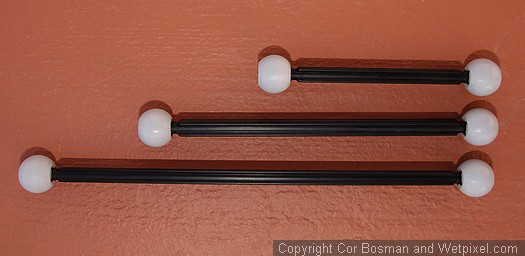
this image shows the bare arms with the ball ends
possible sizes are 4, 6, 9, 12, 15 inches (6, 9, 12 shown here)
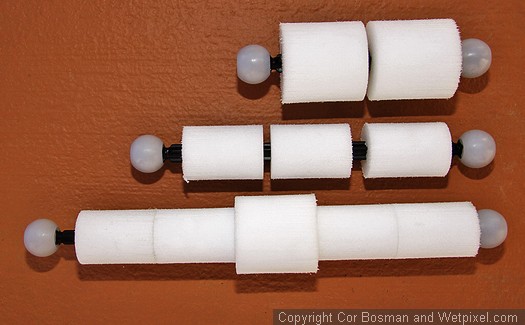
here you can see several configurations of floats on the arms
The arms are very light weight, ideal for traveling. The arms weigh about 20% to 30% less than our ultralight arms, with the 12” arms weighing only 78 grams. The weight of the floats is virtually negligible, at a mere 1.5 grams for every 43 grams of lift added to your rig. At first you may think this light weight translates into weak material. This does not seem to be the case. The arms are made of 40,000 psi tensile aluminum (with competitors usually at 30,000 psi), and have been extensively tested by the designer. In our 200+ dives with these arms there is no visible damage or warping. Here is what the designer John Zeiss says about a test he did comparing his arms with another brand (name withheld) to find their force limits:
“In a simple test where I applied 200 pounds to the center of 12” arms suspended between two blocks, both arms bent. There was a noticeable difference in the ease at which they bent and the degree of spring back; the StiX being the stiffer of the two. The [****] arms showed visible signs of fatigue.”
The ball ends are made of an extremely tough material called Polyetherimide, a high performance thermoplastic. They feel very hardened, and even though it is a type of plastic, they seem well made for the job. Don’t forget, some manufacturers make their whole housing with plastic! An early prototype version we tried was made of a totally different material (Polyphenylene oxide) and was unfortunately prone to cracking. With these new ball ends that problem seems permanently solved.
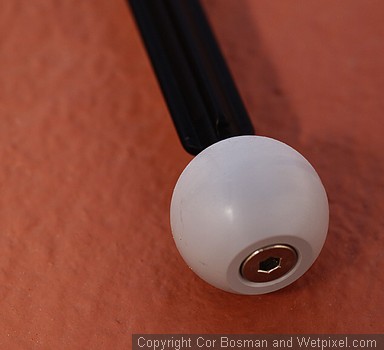
Closeup of the polyetheremide ball ends
The ball ends are attached to the arms with a simple screw that keep the cross shaped arms connected to the arm ends. It takes only a few seconds to undo the screw, replace the floats, and put the screw back on, thereby altering the buoyancy characteristics of the arms. We have noticed though that if not properly maintained the screws tend to get sticky and are hard to loosen. That is in fact how the prototype ball ends cracked, we put too much force on the screw. But like anything that has to do with diving, if you just grease the screws and rinse them regularly there’s absolutely no problem. I do suggest using the little tool that comes with the arms to undo the screws. When we used our own tool, with less sharp edges, the screws got slightly damaged. This does not happen with the tool that comes with it.
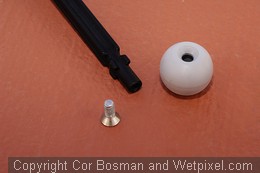
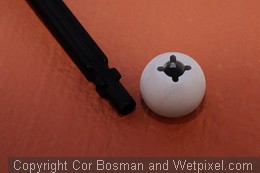
The ball ends slide onto the grooves in the arms and are then held in position with a small screw
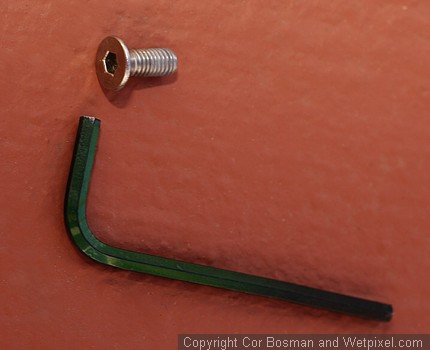
Use the tool that comes with it
The floats are the key to the whole arm system. Because they slide directly onto the arms, the bulk of the arms is not significantly increased compared to other buoyancy arms, and in many cases is much smaller than most other types of housing buoyancy devices. They are made with closed cell polyethylene foam and provide an excellent balance between flotation and durability. In over 200 dives made with these foam pieces we have not damaged a single one. What impressed me the most is that they seem to maintain their form very well at depth, I only noticed a minor difference in buoyancy at depths over 100 feet. The floats come in two sizes, 40 gram lift and 90 gram lift, which allows you to fine tune your rig to a high degree. I was pleasantly surprised that I could easily make my Subal/D2x housing neutral in the water, even though I was using a 60mm macro lens with teleconverter and short macro arms.
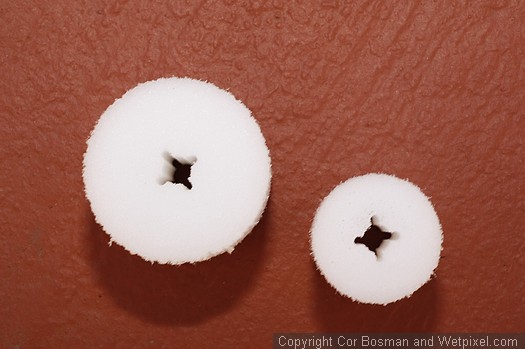
the floats come in two sizes and slide onto the arms
We currently own a set of ULCS (Ultralight) arms, which are also very good quality arms. I especially like the ULCS clamps, so I decided to keep using my ULCS clamps with these new arms to save some money. You can also order clamps from John to match his arm system, and I believe his clamps are slightly lighter. Since I did not order them, I can’t comment on them except to say that when I used them on the Bilikiki they seemed perfectly fine.
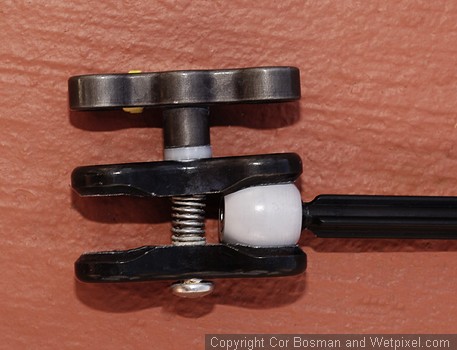
The ULCS clamps can be used with these arms, saving some money if you already own them.
You can also order clamps to go with these arms
The one negative I can think of concerning these arms has to do with the price. As a standalone arm system for those that do not already own strobe arms, the price is actually extremely good at $35 for each arm no matter what the length. That’s quite a bit cheaper than for instance ULCS. But if you already own arms, replacing them with this system is relatively expensive. For my whole system I spent about $300, and now I have a bunch of ULCS arms I don’t use. That is a lot of money to make your rig more buoyant. Perhaps I can sell the ULCS arms, but thats not a certainty. But for me the choice between spending $300 or having my arms hurt after almost every macro dive was easy. When I’m out there in the middle of nowhere doing the amount of diving I do, physical discomforts are not to be taken lightly.
Needless to say, I’m very happy with these arms made by John Zeiss. It has made my diving 100% pleasurable again. No more sore arms after a dive, no more giving up on a very difficult macro subject due to fatigue. My rig is now ever so slightly negative (I prefer it that way), but I can just as easily make it fully neutral or even positive. There does not seem to be any serious additional drag due to the floats because this system adds very little bulk to your rig compared to normal arms.The rig is even easier to carry above water! I couldn’t have asked for more.
Some Facts:
Available sizes: 4,6,9,12,15 inches (6,9,12 shown here)
Arm material: 40,000 psi tensile aluminum
Ball end material: polyetherimide thermoplastic
Float material: closed cell polyethylene foam
Float sizes: 40 gram and 90 gram buoyancy
Price: $35 for the arms, $3 for 40gr float, $4 for 90gr float, $35 for clamp (extra ball ends $15)
Information: http://www.4gdphoto.com/ (site seems not fully finished at the time of writing)
-Cor Bosman / Julie Edwards

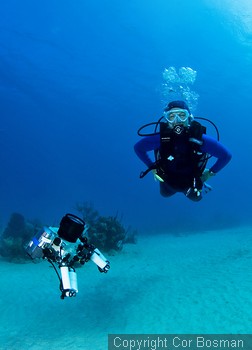
Julie let go of her Subal/D2x with 60mm+TC. It descended very slowly because we decided to make it slightly negative. It took 15-20 seconds to descend the distance between these photo

Cor fell asleep??
Addendum by Wetpixel member Colin Gans (Colin)
My Stix strobe arms arrived yesterday. I’ve been busy shaping the end floats to allow the arms to fold closer together. I like the rounded-off look - makes them look more hydrodynamic even if it doesn’t make much difference ;) .
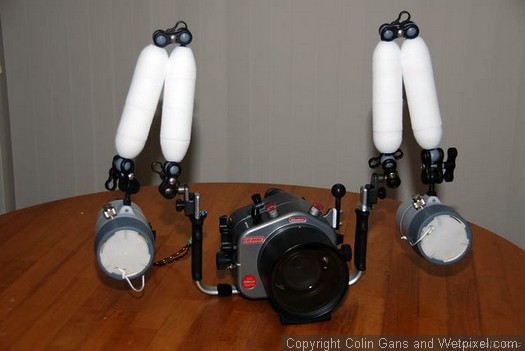
Rounding them was simple as an arm shaft detached from the balls at either end is thin enough to fit into a drill chuck just like a drill bit. I used an electric drill as a lathe, shaping each float (which was slid down the arm shaft) with a rasp file to get a nice rounded finish. The drill did the spinning and I simply held and slowly moved the file to shape the edges. Each arm now has two rounded floats; one at each end. This gives them a ‘torpedo’ look and allows them to fold closer together.

-Colin